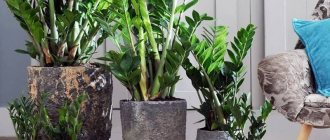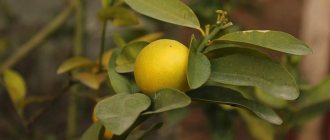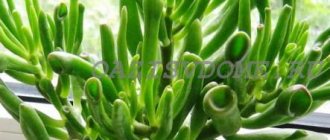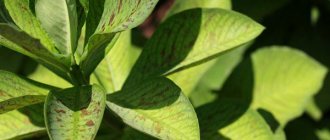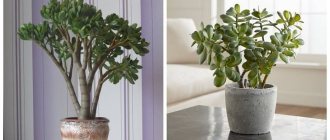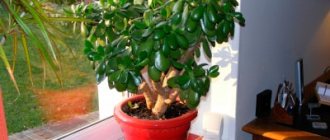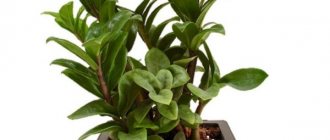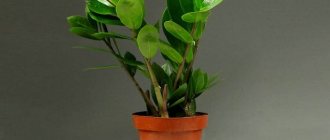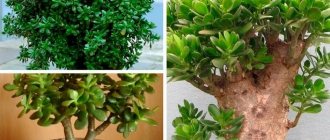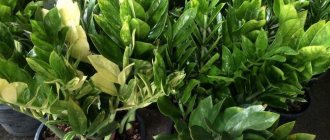Zamioculcas is a large evergreen plant from the araceae family. Grows in the form of a bush. Its homeland is the eastern, mountainous part of Central Africa. The leaves are leathery, small, located on long branches.
Dear readers! For you, we have created communities on social networks in which useful articles and interesting ideas are published several times a day! Subscribe and receive useful content in a convenient format!
The stem is thickened and short. The root system consists of many tubers protruding slightly from the ground. In a room or winter garden, Zamioculcas can reach a height of 1 m. Currently, several dwarf varieties have been bred, the height of which does not exceed 60 cm, which is very convenient for small spaces; such Zamioculcas are easier to care for.
Reference! Until the mid-90s of the last century, Zamioculcas was practically unknown to a wide range of amateur gardeners. Only in 1996 was it first presented at a flower exhibition in Holland, and in 2007 the first cultivar was created - a miniature form.
Now Zamioculcas is becoming increasingly popular. It is valued for its beautiful appearance, unpretentiousness and ease of care. The second popular name for Zamioculcas is the dollar tree.
According to the traditional Chinese teachings of Feng Shui, it is believed that he, like the crassula (money tree), is responsible for the financial well-being of the owners of the house.
And if the plant is healthy, well-groomed, with clean leaves, then wealth in the house will increase.
Currently, you can buy this flower in almost any flower shop, and the prices for it are not so high.
Caring for Zamioculcas after purchase
You should not replant the dollar tree immediately after purchase.
Wait a few days, let it acclimatize to the new conditions and the new microclimate of your home. A ceramic or clay pot is best suited for planting, since the roots of Zamioculcas are powerful and, when growing, can simply tear the plastic container.
The volume of the pot should not be large, about 3-4 cm larger than the diameter of the root system.
Features of Zamioculcas
Zamioculcas is an evergreen perennial and succulent. Found naturally in the tropical forests of the African continent. In Russia, Zamioculcas is known as the dollar tree.
Breeding and growing the plant does not cause much trouble, so it is actively used in landscaping offices, terraces and loggias. The dollar tree does not look quite ordinary: it does not have a trunk or stems, and what grows from the ground is called a compound leaf and is formed from the root system of the plant (see photo).
But the main feature of the indoor Zamioculcas flower is its ability to accumulate moisture reserves, which it uses during unexpected droughts. If there is no water for a long period, then the plant enters the dormant phase, shedding its leaf blades.
Growing conditions or how to care for it?
Growing zamiakulkas at home is not at all difficult. You just need to remember the original growing conditions. Its homeland is the mountain plateaus of Central and Eastern Africa. Consequently, it loves warmth, bright sunlight and very moderate watering. Let's take a closer look at some of the features:
Temperature
During the period of active growth (from April to September), the optimal temperature will be +25.
It also tolerates an increase to +30. In the summer, you can take the zamioculcas out into the fresh air, where the dollar tree will feel very good. In winter, during the rest period, the temperature should not fall below +12. Can't stand sudden changes or drafts.
Humidity
Spray with settled warm water, not often, about once a week and little by little.
The leaves are periodically wiped from dust with a damp cloth (you can use special polishes to give them shine). It will be very good if you place the pot with zamioculcas in a tray filled with damp moss or small pebbles, which should be moistened from time to time.
Lighting
Loves bright but diffused light. It should be shaded from direct sunlight, otherwise burn spots may appear on the leaves. Can be placed on a south, south-west window or a place near a window.
When is support needed?
Adult specimens of Zamioculcas can reach a height of 1 m.
In this case, the branches under their own weight will fall apart and the Zamioculcas will fall to one side, which can lead to the branches of the flower breaking.
As a support, you can use a ring made of strong wire or wood.
Where is the best place to put a dollar tree?
While the dollar tree is young and small in size, as mentioned above, a south or southwest window is suitable for it. Large flowers are very good for outdoor display.
Possible problems during cultivation
Yellowing of zamioculcas leaves
Caring for and maintaining a flower at home is not difficult, but some problems may arise. There are different ailments, but they have solutions:
- The tree stretches and loses its natural color. This means that the plant does not have enough lighting. The solution is to move the pot to a bright place.
- The roots rise to the surface, spots appear on the leaves - Zamioculcas does not have enough space in the pot. The solution is to transplant into a larger container.
- If the leaves turn yellow, most likely the roots have begun to rot. It is recommended to remove the plant from the ground, remove rotten roots, and sprinkle healthy roots generously with activated carbon. Dry the zamioculcas for 3-4 days and plant it back. Leaves may also turn yellow while new leaves are growing. Don't worry if new branches appear on old branches.
- Spots appear on the stems and leaves. The cause of the disease is a fungus. Eliminated with antifungal drugs. It is important to stop feeding during this period; the rest of the care remains.
Bloom
In indoor conditions, Zamioculcas rarely blooms.
To do this, create optimal care conditions for it, one of the main ones being compliance with the temperature regime in winter. If all goes well, the dollar tree will delight you with flowering.
The inflorescence is not quite ordinary - it is an ear, reminiscent of corn, white with a yellowish tint, bordered by a greenish blanket.
The bud comes from the base of the flower, from the ground itself, just like the leaves. From a botanical point of view, the structure of the flower is very interesting. The upper part of the spadix consists only of male flowers, and the lower part only of female flowers. Moreover, they are separated by several rows of sterile flowers. It is clear that with this arrangement, self-pollination of Zamioculcas is impossible.
What is Zamioculcas
Zamioculcas zamiifolia is otherwise called Zamioculcas zamifolia. This is the only representative of the monotypic genus Zamioculcas, family Araceae. Flower growers call it this: money, currency or bucks tree. Other “names” are women’s happiness, the flower of celibacy.
The plant's homeland is the desert parts of Africa. On this continent, it often grows among other succulents, which also store invaluable moisture in the fleshy leaves and other parts (stems, roots) for the upcoming drought.
Zamioculcas
Zamioculcas has a large underground tuber. The leathery large leaves have a characteristic waxy coating. They are erect, feathery, grow from fleshy thick petioles. The currency tree rarely blooms, especially in homes. The inflorescence of Zamioculcas is an 8-centimeter spadix with medium-sized flowers. It is barely noticeable because it forms only in the lower part of the plant and is covered by a large leaf. The flowers are often small, light/cream, and inconspicuous.
Transfer
The best time to transplant zamioculcas is spring.
Young plants are replanted annually. Adults - only when the roots begin to emerge from the drainage holes. Take a pot that is just a little larger. Be sure to add drainage, about 1/4 of the pot.
The soil should be light, moisture- and breathable, with an admixture of sand. You can add fine expanded clay to it. The substrate is good for cacti and succulents.
The root system of Zamioculcas is dense tubers, quite fragile. If they are damaged, the plant may die.
Therefore, it is better to replant using the transshipment method, with a lump of earth. In this case, the tubers cannot be completely covered with soil. They should be open at the top by about 1 cm.
Very large, mature plants are not replanted, but simply replace the top layer of soil in the pot with a new, more fertile one. To do this, carefully, so as not to damage the tubers, remove 5-6 cm of soil, and then just as carefully add fresh soil.
Features of the flower
Zamioculcas is an evergreen plant of the araceae family.
In nature, in its homeland in East Africa, it grows in the same conditions as succulents. It looks like a bush with several fleshy petioles. The leaves are closely set, oval in shape with pointed ends, leathery, rich dark green in color. Zamioculcas can store water in all its parts in order to expend the reserve during the dry period.
At home, it can live from five to ten years, growing up to one and a half meters in height. A large, well-developed plant can bloom ; its small cream-colored flowers are collected in a spadix on a low peduncle.
Due to a long absence of water, a houseplant can shed its leaves and go into a dormant state.
Fallen leaves germinate well, form tubers from which new plants develop. Zamioculcas grows quite slowly; during the course of a year, on average, three new leaves are formed on each feather.
There are different versions of the origin of the popular name Zamioculcas. There is an opinion that the plant was named the dollar tree because of its rich green leaves. Some believe that the shape of the plant is similar to the dollar symbol. But, rather, the similarity of the fleshy leaves of the “money tree” with the leaves of Zamioculcas was the reason for such a promising name.
Having been “domesticated”, zamioculcas began to be used to decorate the interior of living rooms and office premises. The plant fits well into the decor of spacious halls and grows well in rooms with dim lighting.
Reproduction at home
Zamioculcas is most often propagated by division during transplantation.
The tubers are cleared of soil and carefully separated from each other. Each division should have a leaf with a bud and several roots. Young plants are planted in separate small shallow pots. At first after planting, caring for them consists only of very limited watering. The first feeding is applied only after a new young leaf appears.
You can also propagate Zamioculcas from leaf cuttings.
To do this, use a sharp knife to carefully cut off a leaf with a bud at the base of the dollar tree. The cut area is immediately sprinkled with activated carbon powder.
The resulting cutting is dried for several hours. Then they are planted in a container filled with loose soil, slightly buried and watered a little. The container with the cuttings is placed in a warm place, out of direct sunlight. Usually the roots appear within a month. But more is possible, so be patient.
Water the cuttings exclusively by spraying, infrequently and little by little. To speed up the process, you can cover the top with plastic film to create a greenhouse effect and reduce evaporation. However, in this case, the container with the cuttings is ventilated from time to time to avoid rotting.
Cuttings
This propagation method is not as simple as dividing the roots, but it can be applied even to young plants. To do this, cut one of the stems just above the soil level. Be sure to sprinkle the cut area on the mother plant with crushed coal so that the “wound” heals faster.
Cut the shoot itself into pieces so that each of them has a piece of stem with a leaf and a bud. Air dry these cuttings for an hour and then press them into vermiculite poured into plastic cups.
Water the planting generously and place it in a warm and bright place out of direct sunlight. Maintain a temperature of +25 degrees near the plants, and do not forget to regularly spray the vermiculite with warm water from a spray bottle. But don't go too hard, and remember that this material should be damp, not wet.
In such conditions, cuttings will take root from 2-3 weeks to a month. When the plants are strong enough, transplant them into small individual pots and then provide them with regular care.
Trimming
Pruning zamioculcas is needed to form the crown of the plant, improve its illumination, and remove yellowed, diseased or bare branches.
Using pruning, you can give the crown of a dollar tree a ball shape.
It is best to prune during the period of active growth, in spring or summer. If you do this during dormancy, winter sleep, the branches will be weak and pale, and the appearance of the plant may deteriorate.
Lighting
Zamioculcas has taken root well in Russia, but it will appreciate some reminders of the tropics.
- Choose a sunny window for a permanent location: south is ideal, west and east are acceptable.
Without sufficient lighting, Zamioculcas tends to stretch out and get sick, losing its decorative appearance in the struggle for light.
- Important: also avoid overheating when the leaves “burn” in very strong heat without ventilation.
In general, in nature, Zamioculcas often grows in rocky and mountainous areas, sometimes in forests, so shading, drought and any extreme changes are not fatal for it.
You can often see Zamioculcas as an outdoor plant decorating offices, reception areas, etc. A dollar tree, gradually accustomed to the shade, will live calmly even away from the window.
Rejuvenation
Plant rejuvenation is the division of an old, heavily overgrown zamioculcas bush during its transplantation.
In addition to formative pruning, rejuvenating pruning is also carried out. This means that it is necessary to remove old branches that have lost their decorative appearance. After pruning, ugly stumps often remain at the base of the flower. They can be very carefully removed during transplantation.
Carefully! Zammokulkas juice contains substances that, if it comes into contact with the skin, can cause burning, redness, and allergic reactions in the form of a rash. Therefore, all work on transplanting, planting, propagating and pruning should be carried out only with rubber gloves. But for this reason, you should not refuse to grow such a beautiful, spectacular flower. When it stands on a windowsill or on the floor, it does not harm anyone.
How to replant a plant
To prevent transplantation from harming the plant, follow the following algorithm of actions:
- Place a thick layer of broken brick, pebbles or expanded clay drainage at the bottom of the zamioculcas pot. Please note that this layer should occupy at least ¼ of the volume of the flowerpot. Cover the drainage with the prepared substrate.
- Carefully remove the flower from the old pot. To make this easier, moisten the soil first.
- Remove old soil and, if necessary, cut out soft roots and shoots that emit an unpleasant odor. Sprinkle the cut areas with crushed charcoal.
- Place the plant in a new pot and fill the voids with soil. Please note that the depth of planting the flower should be the same as before. After all, if you deepen the growing point of a plant too much, it will rot.
Water only after 1-2 days. This is necessary to ensure that moisture does not get on the injured roots, which can cause them to rot. And also for the first time after transplantation, keep the flower in partial shade. And only when the zamioculcas takes root, return it to its usual place.
Watering
Watering all year round should be very moderate.
As they say, “it’s better not to top up than to overfill,” because over-moistening of the soil causes rotting of the roots. Excess water from the pan is immediately drained, preventing it from stagnating.
In the summer, water the zamioculcas when the soil in the pot dries well. In winter, even less often, 1-2 times a month is enough. Thanks to its tubers, thick stems and dense waxy leaves, the plant, like succulents and cacti, has the ability to store moisture and then use it as needed.
Attention! Overwatering is worse than drought for Zamioculcas! Remember this when caring for your flower.
Humidity
Zamioculcas easily tolerates the dry air of an apartment, and does not need spraying. However, it is advisable to wipe the leaves of the flower with a damp cloth once a week. Otherwise, dust will accumulate on them. And this will have a bad effect not only on the decorative appearance of the plant, but will also worsen its health, because dust will block the access of fresh air to the leaves.
In addition, it is recommended to give the succulent a warm shower once a month. To do this, take the flower to the bath, cover the soil with polyethylene and wash the leaves and stems under low pressure of water. Then wait for the excess liquid to drain, and only then return the pot to its usual place.
Feeding and fertilizer
Feeding is another component of care.
During the period of active growth (from April to September) feed 1-2 times a month, no more often. Typically, fertilizers are used for cacti and succulents. The concentration of the feeding solution can be made less than indicated in the instructions for use of the drug.
In general, the situation with fertilizing is the same as with watering: it is better to underfeed than to overfeed. Young, newly transplanted zamioculcas plants are not fed until new fresh leaves begin to appear.
Important! In winter, during the dormant period (from October to March), feeding is stopped.
Growing Zamioculcas
Zamioculcas is not a demanding plant, so even a beginner can cope with its cultivation and care. Nevertheless, you need to follow some rules, understand the characteristics of the plant, know its needs and how they are satisfied in natural growing conditions. All this is necessary in order to, when growing zamioculcas in the house, recreate conditions for it that are as close as possible to natural ones.
Diseases and pests
Zamioculcas is very rarely affected by pests and diseases.
Sometimes scale insects, spider mites or aphids appear on it. If they are detected, it is necessary to thoroughly treat the plant itself and the soil in the pot with a solution of a suitable insecticidal preparation.
If you don’t want to use chemicals, you can try some folk remedies to control pests. For example, from spider mites, the plant is pollinated with ground sulfur (this should be done outside the living room).
Treatment with a low concentration tobacco solution also gives a good effect. To get rid of aphids, sometimes it is enough to simply wash the crown under a strong stream of water (the soil in the container with the flower must be covered with film so as not to flood the tubers).
Spots on the leaves may be the result of a fungal infection. To combat it, appropriate drugs are also used. The appearance of diseases is usually a consequence of improper care. For example, with excessive watering or stagnation of water in the pan, stem rot is observed - the leaves begin to dry out and gradually fall off.
Zamioculcas pests: control methods and prevention (table)
Zamioculcas is characterized by increased resistance to pests, which infrequently, but still infect the plant.
| Pest | Symptoms | How to treat | Prevention measures |
| Shchitovka | The leaves of the plant are covered with dark tubercles. Young larvae are able to crawl throughout the plant. | Aktellik, Aktara - strictly according to the instructions. Be sure to use personal protective equipment - gloves, gauze bandage. Processing is best done outdoors. If the treatment is carried out indoors, be sure to open the window. A day after treatment, wash the plant well. |
|
| Aphid | Aphids can completely destroy a plant if measures are not taken. The pest is gray, green or black in color. It can be found on the underside of the leaf and on the apical shoots. It feeds on plant sap. It spreads very quickly. |
| |
| Spider mite | The affected areas of the plant are entwined with cobwebs, on which there is a colony of mites. The color of insects is usually grayish, greenish or brown. Non-feeding wintering females are red. They feed on plant sap. Small white dots appear on the leaves. |
|
Photo gallery: how to recognize pests
This is what a plant infected with spider mites looks like
If you don't take action, aphids will spread very quickly.
A plant affected by scale insects becomes covered with dark tubercles.
How to revive a houseplant?
The question often arises: how to revive zamioculcas that has begun to rot?
You need to immediately remove it from the pot, carefully free the roots from the ground and carefully examine them, rinse thoroughly in a weak solution of potassium permanganate.
Cut off all rotten areas with a sharp knife and peel back to healthy tissue. Be sure to sprinkle the sections with activated carbon powder. Let them dry for several hours.
In the meantime, also treat the pot with a solution of potassium permanganate, fill it with fresh soil and plant the zamioculcas again. Don't water it for a while. In the future, to avoid any troubles, try to avoid mistakes in care.
Zamioculcas - care
The aroid palm does not require special attention. On the contrary, excessive watering, spraying and “stuffing” fertilizers can ruin the plant.
Zamioculcas prefers bright, diffused light However, it easily acclimatizes in direct sunlight and in the depths of a northern room. But you should not sharply change the lighting intensity - all endurance has a limit.
It will live in places where artificial flowers mostly have to be placed - you can place an adult specimen in a shaded area and limit watering. The plant will not die, will not lose its appearance, it will only stop growth and will remain in this mode for several years. For its extreme unpretentiousness, it has earned the sympathy of designers.
The heat-loving Zamioculcas is demanding in only one thing - in summer it desires almost thirty-degree heat, and in winter it should not be placed where the temperature is below plus 16. Drafts are not welcome and can even lead to massive yellowing of the leaves.
Light soil is a prerequisite for the well-being of the dollar palm. Even if the substrate is poor, nothing bad, these are exactly the soils to which Zamioculcas is accustomed in nature. Suitable turf soil loosened with sand (60% and 40%, respectively), perlite or vermiculite. Another composition is leaf, turf soil, sand and small pebbles - 1.5: 1: 1: 0.5. If you have doubts that the local soil is good enough, you should buy a soil mixture for succulents or cacti.
Some soils, especially in the taiga zone, have an acidic reaction. To get the soil close to neutral, add a pinch of lime. Drainage should occupy at least a quarter of the height of the container. The bottom of the vessel must have holes for water drainage.
Transplantation is an infrequent operation. The young plant is transplanted once a year, usually in early spring. The “apartment” for the dollar tree needs to be chosen to be of good quality, to match the occupant. The container must be heavy, otherwise it will tip over: after all, the leaves are long, fleshy and quite heavy.
[!] Attention! All parts of the plant contain toxins. You should work with gloves.
The new vessel is chosen not much larger than the previous one - so that there is a distance of 1-2 cm between the tuber and its walls. During transplantation, the tuber should not be buried in the ground. Much like a beet root, it will protrude slightly above the surface. It is convenient to combine replanting with dividing the rhizome. Zamioculcas planted in fresh soil is placed in a shaded place for two weeks and watered very moderately, only moistening the surface of the substrate.
For tall specimens, a wide container is more suitable - in it the plant looks harmonious, and in this case it is easier to replant. Zamioculcas aged 5 years and older can be left in the same pot, replacing only the top layer of soil.
Emergency transplantation is carried out if the root system is rotten. As a rule, this is the result of excessively generous watering and heavy soil. The problem is externally expressed in the fact that not only the old leaves of Zamioculcas turn yellow, but also the young ones. The base of the petiole softens and the leaf bends towards the ground. You need to carefully (with a brush) clean the tuber from any remaining soil, rinse it in a weak solution of potassium permanganate and dry it. Then remove all rotten roots, and, if necessary, remove part of the tuber itself. The sections are sprinkled with ash, you can sprinkle them with Oksikhom or Fundazol. The above-ground parts of the plant are treated with the same preparations. The container is disinfected and the soil is completely replaced.
Watering zamioculcas can be characterized by one phrase - “less is better.” In the sense that it is necessary to water the plant rarely, until the earthen clod has almost completely dried out. But the water must be soft and, very preferably, warm.
A dollar palm tree can be left for a month and a half without watering at all - when going on vacation, you should not water the tree “in reserve”, because it has its own reservoir of moisture - the rhizome.
[!] Watering the plant from a tray is highly not recommended! This is the surest way to rot the main root.
You can spray the money tree, but not very often. Direct sunlight should not fall on wet leaves - drops of water will act like lenses, and the plant will get burned. It is much more useful to remove dust from the leaf blades with a damp cloth - they acquire a characteristic waxy shine. Many even use a leaf polishing composition to enhance the decorative qualities of the plant.
Air humidity is absolutely not critical. Zamioculcas is able to live in a humid greenhouse and in an office overdried by air conditioning - natural hardening takes its toll.
Fertilizers should be applied carefully. An overdose can lead to metabolic disorders and plant death. As with watering, the rule applies - it is better to give too little than to give too much. Zamioculcas is suitable for mineral complexes for cacti and succulents. The dose is reduced by half compared to the recommended one.
Reproduction and developmental features of Zamioculcas
Any healthy part of the plant is suitable for procreation. It can be a rachia petiole with a nodule at the base (“baby”), a whole leaf, part of a central tuber, a root with a growing point, or even a piece of a leaf blade. The planting material is dried for 1-2 days and placed in a loose substrate - sand, vermiculite, etc., slightly buried. Cover the top with a transparent cap or film. You need a temperature of plus 25°C and good lighting, but not full sun.
The differences will only be in the timing of emergence. The fastest time - in 2-3 weeks - the “baby” takes root, a little longer - the divided tuber. To grow a dollar palm tree from a piece of leaf, you need to be patient for six months or more.
For some owners, Zamioculcas behaves “the other way around” - it begins to grow in the depths of winter and does not show signs of life in the spring. The Chinese nicknamed it “crazy palm tree” for its unpredictability. But it comes from a different hemisphere, and was “domesticated” quite recently, and this explains everything. Plants have adapted and changed their biorhythms, but those that are especially stubborn live according to their internal “clocks.”
[!] In some cases, the rooting of zamioculcas is much more effective in the fall than in the winter - again, due to “inverted” development cycles.
Pests and diseases
Usually insects bypass the African guest. A weakened plant can be attacked by a scale insect, or less often by a spider mite. It is enough to mechanically remove pests and improve care.
Root rot is a dangerous disease (see above).
Possible mistakes during care
Let's look at some of the most common mistakes associated with home care:
- Excessive watering. Signs: leaves turn yellow and gradually dry out. The roots and stem begin to rot. Replant, and immediately.
- Insufficient lighting. The plant loses color, the branches become thin and elongated. Appearance deteriorates. Move to a more suitable, illuminated place.
- Insufficient air humidity. This is especially true in winter, when dry air comes from hot heating radiators. The tips of the leaves become dry and brittle. Spray it more often with warm, settled water or place the dollar tree pot in a tray filled with damp moss, expanded clay, pebbles, and shells, which are moistened from time to time.
Attention! If the old leaves turn yellow but new branches with green leaves appear, this is normal, just trim off the old leaves.
Zamioculcas grows very slowly. Moreover, this does not depend on the conditions of its maintenance, the same thing happens in nature, this plant has such characteristics. Sometimes it can simply “freeze” for a while and not grow at all. There's no need to be scared, it's okay. If the zamioculcas looks healthy and there are no pests, everything is fine.
Popular types
Zamioculcas appeared in flower shops 20 years ago. During this time, breeders have developed several different species, the most popular of which for home cultivation are:
Zamioculcas zamiifolia
Zamioculcas zamifolia / Flowering
This is the most typical representative of the plant . This is what refers to the “money tree”. A beautiful ornamental bush with bright fleshy leaves. The plant looks so perfect that it feels like it is artificial. An amazing plant that hides its trunk in the soil. For the first time weeks after growth, the flower does not form roots. Instead, there is a tuber that stores large reserves of water. The tuber is somewhat reminiscent of a dark marsh or brown potato. Has the shape of an ellipse.
Looking at the pot with the plant, it seems that bright green leaves are growing directly from the soil. The leaves are attached to the tuber using a long stalk, which unknowing gardeners mistake for the trunk. The length of the leaves reaches 60 centimeters . The leaves grow from a tuber and are divided into 8-12 individual leaflets. This is very rare for this species. The feather is dense, glossy and has a thick, juicy axis in which the flower stores moisture.
The plant grows in height very slowly. The cost of a shrub in a flower shop depends on its height; the longer, the more expensive.
Zamioculcas variegate
Zamioculcas variegated
Variegated or variegated Zamioculcas is very difficult to find in flower shops. His homeland is the island of Madagascar. At home it can reach a height of 1 to 1.5 meters. The leaves are arranged symmetrically in strict order. They have a bright green color, juicy flesh, and pointed ends. Flowers rarely appear on the plant, with very good care. The inflorescence is formed in the shape of a spadix.
Zamioculcas lanceolata
Zamioculcas lanceolate
Received this name because of the elongated leaves of the original lanceolate shape. The flower was first exhibited at flower auctions in Holland at the end of the 20th century. Its height reached 1.5 meters and above. In 2007, a miniature plant was bred, not exceeding 60 centimeters in height. Its leaves are an exact copy of its progenitor, only in a reduced size.
Black zamioculcas (Zamioculcas Blak)
Black Zamioculcas
The plant has leaves and cuttings of almost black color. Otherwise, it is completely similar to Zamioculcas zamifolia. The same fleshy leaves, pointed at the tips, attached symmetrically on both sides on a common stalk. The young bush has salad-colored leaves. As they mature, they begin to darken. At the same time, their color is not affected at all by the lighting in the room. No matter how the florist tries to lighten the leaves, he will not succeed. This “tree” looks very impressive. Therefore, it will perfectly decorate any room.
FAQ
Quite often, questions arise when growing zamioculcas.
Why is it growing poorly? Why doesn't it produce new shoots?
There may be several reasons, they are mainly related to improper care of zamioculcas: insufficient lighting, a cramped small pot, improper planting - buried tubers or lack of a drainage layer in the pot, too low a temperature, drafts during the winter dormancy period.
Perhaps the dollar tree was recently purchased or replanted and is simply getting used to its new surroundings.
How often does it bloom?
At home, Zamioculcas blooms very rarely, and if it does bloom, it is already in adulthood.
It is necessary to create the most optimal conditions for it, but even then, very young plants most likely will not bloom.
However, as with any rules, there are exceptions here, and for some gardeners who love their pets very much, zamioculcas can bloom at an earlier age.
What to do if a branch breaks off?
Carefully cut it off at the very base of the stem with a sharp knife and be sure to sprinkle the cut with activated carbon powder.
According to numerous data from the forums of amateur gardeners, the main reasons for failures when growing zamioculcas at home are excessive watering, as well as non-compliance with the conditions of maintenance and care during the winter dormancy period, when the plant needs low air temperature combined with humidity.
Features of care
Caring for zamioculcas at home involves performing the following procedures:
- regular watering;
- timely application of fertilizers;
- transfer.
It is recommended to periodically bathe the plant under a warm shower. During this procedure, the soil should be protected from waterlogging.
Watering
The plant should be watered in spring and summer as needed, namely when the top layer of soil dries out. It should be borne in mind that zamioculcas tolerates a lack of moisture much more easily than its excess, so you should not overwater it.
With the onset of cold weather, it is recommended to reduce the frequency of watering to the maximum to prevent rotting of the roots. It is necessary to water the plant only with warm, settled water, since cold liquid causes growth to slow down.
Fertilizer application
The first feeding is carried out in the spring after planting the plant in a pot. Fertilizers should be applied during active growth. In winter, it is not advisable to feed Zamioculcas.
There are 2 processing methods:
- Watering the root system. Most fertilizers are applied this way.
- Irrigation of leaves. You can only spray a healthy plant that does not have any signs of disease or depletion.
Agricola for succulents is suitable for watering the root system of Zamioculcas. This product dissolves in water without sediment. It is necessary to fertilize the root system with it 3 times a month. To prepare the solution you will need to dilute 1 tsp. Agricola in 2 liters of water.
For spraying zamioculcas, it is recommended to use the drug Agricola Aqua. This remedy accelerates the growth of the plant. It is recommended to carry out the spraying procedure no more than once a month.
Transfer
Zamioculcas does not tolerate transplantation well. It is recommended to carry out this procedure no more than once every 3 years. It is advisable to replant the plant in late winter - early spring.
Recent Entries
Chainsaw or electric saw - what to choose for the garden? 4 mistakes when growing tomatoes in pots that almost all housewives make Secrets of growing seedlings from the Japanese, who are very sensitive to the soil
First you need to prepare a new container. It should be 2–3 cm larger in diameter than the previous one. Then a layer of expanded clay should be placed on the bottom of the pot, fresh soil should be added and the zamioculcas should be moved using the transshipment method. After transplanting, the pot with the plant should be removed for 7 days in a shaded place.
Types of plants with photos and names
Zamioculcas is represented by one species - Zamioculcas zamifolia. Zamioculcas lanceolate was also considered an independent species. There are also several subspecies bred when grown as a houseplant.
Zamiifolia
The trunk of the plant is in the ground, which causes the feeling of the leaves emerging directly from the soil. In fact, the leaves are on a cutting growing from a tuber. The length of the leaves reaches 60 cm. The feather of the leaf has a dense structure and shines . Each feather has about 10 individual leaves. Zamioculcas zamiaefolia has a bush 70-90 cm high. The leaves are pinnately complex, bright green, on fleshy petioles.
Variegate
The plant variety has an unusual leaf color with a transition from light green to white. Variegation is caused by cell mutation. Their colorlessness is explained by their inability to synthesize chlorophyll.
Rarely found, mainly among private collectors. This species grows up to one and a half meters. Juicy bright green leaves with pointed tips are arranged strictly symmetrically.
Hybrids of this species are very diverse. Known:
- Lucky White (lucky white).
- Long Liv (long leaf).
- Short Liv (short leaves).
- Big Liv (Big leaves var. yellow).
The most famous variegated variety is Lucky White. It has unusual marbled leaves with white and milky spots and streaks throughout the leaf blade. The size of the bushes is small - 30-40 cm. This variety is fastidious in care.
The Long Liv plant has lemon or yellow streaks on its dark green leaves. The length of the leaf petioles reaches 80 cm.
Short Liv is characterized by white speckles and stripes on the leaves . It has bushes 45-50 cm high, leaves 7-9 cm in size.
The leaves of the Big Liv variety have an unusual color. The color is unusual, yellow, while the petioles are pale green.
Lanceolata
This plant species was described in 1929 by the German botanist Gustav Albert Peter. In the wild it is found mainly in Mozambique . Currently, it is rarely isolated as an independent species. A characteristic feature is the leaves are elongated-lanceolate. There is only one variety of dwarf form. Height – no more than 30 cm.
Black
The unusual coloration of the species gave the plant its name. Other names for the hybrid are Black Raven, Black Prince, Raven or Raven.
Young leaves have a light green tint. As the plant matures, it begins to darken, acquiring a very dark, almost black color.
Otherwise, the black zamioculcas is no different from its counterparts. Thanks to its unusual coloring it is very impressive , especially against a light background. An adult plant can grow up to 75 cm in height, the bush is more compact than other species. This variety was bred in Holland and brought to Russia in 2017. The following year, 2022, he received first place at the international exhibition of tropical plants in the USA.
This representative of East Africa pleases the eye all year round. With all its advantages, it can become a favorite plant, even if it does not bring wealth in the form of dollars.
